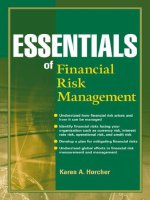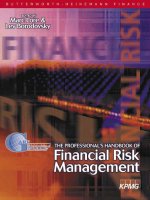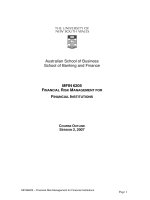Elements of financial risk management chapter 12
Bạn đang xem bản rút gọn của tài liệu. Xem và tải ngay bản đầy đủ của tài liệu tại đây (919.6 KB, 69 trang )
1
Credit Risk Management
Elements of
Financial Risk Management
Chapter 12
Peter Christoffersen
Elements of Financial Risk Management Second Edition © 2012 by Peter Christoffersen
Overview
• Credit risk can be defined as the risk of loss due to a
counterparty’s failure to honor an obligation in part or in
full
• Credit risk can take several forms
• For banks credit risk arises fundamentally through its
lending activities
• Nonbank corporations that provide short-term credit to
their debtors face credit risk as well
• Investors who hold a portfolio of corporate bonds or
distressed equities need to get a handle on the default
probability of the assets in their portfolio
Elements of Financial Risk Management Second Edition © 2012 by Peter Christoffersen
2
Overview
3
• Default risk, a key element of credit risk, introduces an
important source of nonnormality into the portfolio
• Credit risk can also arise in the form of counterparty
default in a derivatives transaction
• The chapter is structured as follows:
• Section 2 provides a few stylized facts on corporate
defaults
• Section 3 develops a model for understanding the effect on
corporate debt and equity values of corporate default.
Elements of Financial Risk Management Second Edition © 2012 by Peter Christoffersen
Overview
4
• Default risk will have an important effect on how corporate
debt is priced, but default risk will also impact the equity
price. The model will help us understand which factors
drive corporate default risk
• Section 4 builds on single-firm model from Section 3 to
develop a portfolio model of default risk. The model and its
extensions provide a framework for computing credit Valueat-Risk
• Section 5 discusses further issues in credit risk including
recovery rates, measuring credit quality through ratings, and
measuring default risk using credit default swaps
Elements of Financial Risk Management Second Edition © 2012 by Peter Christoffersen
5
Figure 12.1: Exposure to Counterparty Default Risk
Elements of Financial Risk Management Second Edition © 2012 by Peter Christoffersen
Brief History of Corporate Defaults
6
• Credit rating agencies such as Moody’s and Standard &
Poor’s maintain databases of corporate defaults through
time
• In Moody’s definition corporate default is triggered by one
of three events:
– a missed or delayed interest or principal payment
– a bankruptcy filing
– a distressed exchange where old debt is exchanged for
new debt that represents a smaller obligation for the
borrower
Elements of Financial Risk Management Second Edition © 2012 by Peter Christoffersen
7
Table 12.1: Largest Moody's-Rated Defaults
Company
Default Volume ($ mill)
Year
Industry
Country
Lehman Brothers
$120,483
2008
Financials
United States
Worldcom, Inc.
$33,608
2002
Telecom / Media
United States
GMAC LLC
$29,821
2008
Financials
United States
Kaupthing Bank Hf
$20,063
2008
Financials
Iceland
Washington Mutual, Inc.
$19,346
2008
Financials
United States
Glitnir Banki Hf
$18,773
2008
Financials
Iceland
NTL Communications
$16,429
2002
Telecom / Media
United Kingdom
Adelphia Communications
$16,256
2002
Telecom / Media
United States
Enron Corp.
$13,852
2001
Energy
United States
Tribune Economy
$12,674
2008
Telecom / Media
United States
Elements of Financial Risk Management Second Edition © 2012 by Peter Christoffersen
Figure 12.2: Annual Average Corporate Default
Rates for Speculative Grade Firms, 1983-2010
Elements of Financial Risk Management Second Edition © 2012 by Peter Christoffersen
8
Figure 12.2: Annual Average Corporate Default
Rates for Speculative Grade Firms, 1983-2010
Elements of Financial Risk Management Second Edition © 2012 by Peter Christoffersen
9
Modeling Corporate Default
10
• The Merton model of corporate default provides important
insights into the valuation of equity and debt when the
probability of default is nontrivial
• The model also helps us understand which factors affect the
default probability
• Consider the situation where we are exposed to the risk that
a particular firm defaults
• This risk could arise from the fact that we own stock in the
firm, or it could be that we have lent the firm cash, or it
could be because the firm is a counterparty in a derivative
transaction with us
Elements of Financial Risk Management Second Edition © 2012 by Peter Christoffersen
Modeling Corporate Default
11
• We would like to use observed stock price on the firm to
assess the probability of the firm defaulting
• Assume that the balance sheet of the company in question
is of a particularly simple form
• The firm is financed with debt and equity and all the debt
expires at time t+T
• The face value of the debt is D and it is fixed.
• The future asset value of the firm, At+T , is uncertain
Elements of Financial Risk Management Second Edition © 2012 by Peter Christoffersen
Equity is a Call Option on the Assets
of the Firm
12
• At time t+T when the company’s debt comes due the firm
will continue to operate if At+T > D but the firm’s debt
holders will declare the firm bankrupt if At+T < D and the
firm will go into default
• The stock holders of the firm are the residual claimants on
the firm and to the stock holders the firm is therefore worth
• when the debt comes due
• This is exactly the payoff function of a call option with
strike D that matures on day t+T
Elements of Financial Risk Management Second Edition © 2012 by Peter Christoffersen
Equity is a Call Option on the Assets
of the Firm
13
• Figure 12.4 shows the value of firm equity Et+T as a
function of the asset value At+T at maturity of the debt when
the face value of debt D is $50
• The equity holder of a company can therefore be viewed as
holding a call option on the asset value of the firm
• It is important to note that in the case of stock options the
stock price was the risky variable
• In the present model of default, the asset value of the firm
is the risky variable but the risky equity value can be
derived as an option on the risky asset value
Elements of Financial Risk Management Second Edition © 2012 by Peter Christoffersen
Figure 12.4: Equity Value as Function of Asset Value
when Face Value of Debt is $50
Elements of Financial Risk Management Second Edition © 2012 by Peter Christoffersen
14
Equity is a Call Option on the Assets of
the Firm
15
• The BSM formula can be used to value the equity in the firm
in the Merton model
• Assuming that asset volatility, σA, and the risk-free rate, rf ,
are constant, and assuming that the log asset value is
normally distributed we get the current value of the equity to
be
• where
Elements of Financial Risk Management Second Edition © 2012 by Peter Christoffersen
Equity is a Call Option on the Assets
of the Firm
16
• Note that the risk-free rate, rf , is not the rate earned on the
company’s debt; it is instead the rate earned on risk-free
debt that can be obtained from the price of a government
bond
• Investors who are long options are long volatility
• The Merton model therefore provides the additional insight
that equity holders are long asset volatility
• The option value is particularly large when the option is atthe-money; that is, when the asset value is close to the face
value of debt
Elements of Financial Risk Management Second Edition © 2012 by Peter Christoffersen
Equity is a Call Option on the Assets
of the Firm
17
• In this case if the manager holds equity he or she has an
incentive to increase the asset value volatility (perhaps by
taking on more risky projects) so as to increase the option
value of equity
• This action is not in the interest of the debt holders as we
shall see now
Elements of Financial Risk Management Second Edition © 2012 by Peter Christoffersen
Corporate Debt is a Put Option Sold
18
• The simple accounting identity states that the asset value must
equal the sum of debt and equity at any point in time and so we
have
• where we have used the option payoff on equity described
earlier.
• We use Dt+T to denote the market value of the debt at time
t+T.
• Solving for the value of company debt, we get
Elements of Financial Risk Management Second Edition © 2012 by Peter Christoffersen
Figure 12.5: Market Value of Debt as a Function of
Asset Value when Face Value of Debt is $50
Elements of Financial Risk Management Second Edition © 2012 by Peter Christoffersen
19
20
Corporate Debt is a Put Option Sold
• Figure 12.5 shows the payoff to the debt holder of the firm as
a function of the asset value At+T when the face value of debt
D is $50
• Comparing Figure 12.5 with the option payoffs we see that
the debt holders look as if they have sold a put option
although the out-of-the-money payoff has been lifted from 0
to $50 on the vertical axis corresponding to the face value of
debt in this example
Elements of Financial Risk Management Second Edition © 2012 by Peter Christoffersen
Corporate Debt is a Put Option Sold
21
• Figure 12.5 suggests that we can rewrite the debt holder
payoff as
• which shows that the holder of company debt can be
viewed as being long a risk-free bond with face value D
and short a put option on the asset value of the company,
At+T , with a strike value of D
• We can therefore use the model to value corporate debt;
for example, corporate bonds
Elements of Financial Risk Management Second Edition © 2012 by Peter Christoffersen
Corporate Debt is a Put Option Sold
22
• Using the put option formula from Chapter 10 the value
today of the corporate debt with face value D is
• where d is again defined by
• The debt holder is short a put option and so is short asset
volatility
• If the manager takes actions that increase the asset
volatility of the firm, then the debt holders suffer because
the put option becomes more valuable
Elements of Financial Risk Management Second Edition © 2012 by Peter Christoffersen
Implementing the Model
23
• Stock return volatility needs to be estimated for the BSM
model to be implemented
• In order to implement the Merton model we need values for
σA and At, which are not directly observable
• In practice, if the stock of the firm is publicly traded then
we do observe the number of shares outstanding and we
also observe the stock price, and we therefore do observe Et
• where NS is the number of shares outstanding
Elements of Financial Risk Management Second Edition © 2012 by Peter Christoffersen
Implementing the Model
• From the call option relationship earlier we know that Et is
related to σA and At via the equation
• This gives us one equation in two unknowns
• We need another equation
• The preceding equation for Et implies a dynamic for the
stock price that can be used to derive the following
relationship between the equity and asset volatilities:
• where σ is the stock price volatility
Elements of Financial Risk Management Second Edition © 2012 by Peter Christoffersen
24
Implementing the Model
25
• The stock price volatility can be estimated from historical
returns or implied from stock option prices
• We therefore now have two equations in two unknowns, At
and σA
• The two equations are nonlinear and so must be solved
numerically using, for example, Solver in Excel
• Note that a crucially powerful feature of the Merton model is
that we can use it to price corporate debt on firms even
without observing the asset value as long as the stock price is
available
Elements of Financial Risk Management Second Edition © 2012 by Peter Christoffersen









